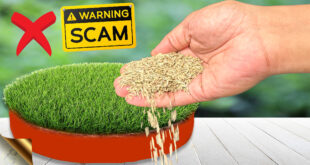In today’s post we will try to identify some common leaf patterns of discoloration and distortion in various micro and macro nutrient deficiencies and Finally One single universal solution or fertilizer to treat these problems.
Before we start displaying the various leaf patterns, you must understand some basics in order to diagnose this problem of nutrient deficiencies in plants and start the right treatment to save your plants. Because directly jumping in to adding too many supplements can burn or kill your plant.
Plant nutrients fall into 2 categories: macronutrients and micronutrients. Macronutrients are those elements that are needed in relatively large amounts. They include the three major ones – nitrogen, phosphorous, potassium, that’s NPK and also sulfur, calcium and magnesium. Micronutrients are those elements that plants need in very small amounts, like iron, boron, manganese, zinc, copper and molybdenum.
Most of the times, except in container gardening, these nutrients may be present in the soil. So before adding supplements you have to diagnose your condition by checking these 3 problems or factors:
- The problem may be with the roots – not able to absorb or uptake these nutrients. This can be due to root disease or improper watering. Because these nutrients are taken up by the roots only in the presence of moisture.
- Soil PH may not be right. Most plants need a PH of around 6.0 for proper absorption of nutrients by the roots. Having this little PH meter will certainly help you rectify this problem. You can find related posts on altering soil PH.
- Pest attacks which can sometimes resemble the patterns of nutrient deficiencies, especially the sucking pests like aphids. Make sure you thoroughly examine your plants.
Now having said that, let’s jump
into identifying the various leaf patterns of discoloration and distortion and
diagnose this problem. But always Keep in mind that each plant variety is
different and may display different symptoms. And also the damaged leaves may not come back
to normal after treatment but the new leaves will certainly come out healthy
and lush after treatment.
Let’s start with:
- Nitrogen Deficiency: you will notice complete yellowing of the older leaves generally at the bottom of plants. The younger leaves are often healthy and green. This is because, nitrogen is a mobile nutrient which moves up from the lower parts of the plant to the growing ends as a compensatory mechanism and hence the older leaves donate nitrogen and show complete yellowing including the veins and the entire leaf surface. The solution to this is simply adding a good nitrogen rich compost like decomposed cow dung or horse dung. But before adding, please rule out the problems of improper watering and soil PH that we already discussed.
- Calcium Deficiency: Here the new leaves are affected and may show yellowing, distortion and even burnt tips due to necrosis or death of the tip tissues. Blossom End Rot (BER) seen in tomatoes and squashes is the best example of this. We have discussed this problem and treatment in detail in my previous post.
- Magnesium Deficiency: Magnesium is also a mobile nutrient and hence The older leaves first turn yellow at the edges and surface – called interveinal chlorosis, meaning yellowing between the leaf veins. The veins as you can see, stay green, giving the leaf a marbled appearance. Remember, Magnesium is the central most atom in the chlorophyll molecule which imparts green colour to leaf. Foliar Spraying or watering the plant with 1 teaspoon Epsom salt per litre of water will give great results.
- Iron Deficiency: Iron is an immobile nutrient and hence cannot be carried upto the younger leaves from older leaves for compensation. So the leaf yellowing is first evident at the tips or the younger leaves. The pattern is similar to magnesium – the interveinal yellowing. This is actually a common pattern and most often due to alkaline soil ph which prevents proper absorption of iron by the roots. Hence its also called as lime induced chlorosis. The treatment for this is actually rectifying the soil ph to around 6, if its alkaline. Another method to bypass this problem is foliar spray of a micronutrient solution or compost tea.
- Phosphorous and Potassium Deficiencies: These are very much similar and plants show stunted growth plus leaf chlorosis like leaves turning darker or purplish. But this is difficult to identify and depends on the type of plant. Isolated Potassium deficiency usually exhibits yellowing starting at the tip or the margin of the leaf with the center being still green.
- Last but not the least, you must be aware of a condition called YELLOW VEIN CHLOROSIS. Here only the leaf veins turn yellow while the rest of the leaf shows normal green colour. This usually happens in winter or the dormancy period due to reduced nitrogen uptake by the roots from the soil in low temperatures.
Now the Universal Treatment Solutions for all these problems:
You have two options: First one is Making The Universal Cocktail Fertilizer mixture.
And the Second option is Vermicompost – which is rich is almost all micronutrients. Adding a handful every 15 days will keep your plants healthy and high yielding.
 GKVKs – Gardening Tips and Store Gardening Tips and Store
GKVKs – Gardening Tips and Store Gardening Tips and Store



